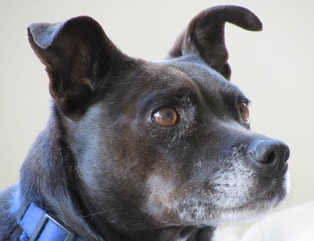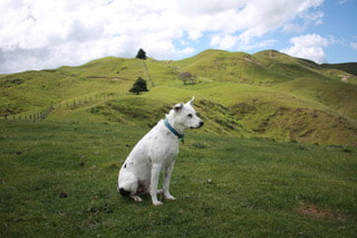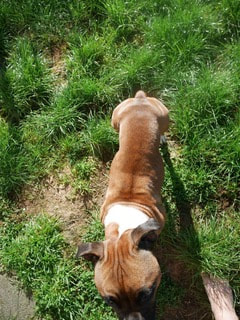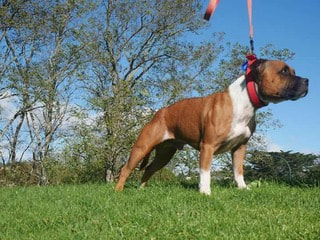 Bruce's skin was a chronic problem despite conventional treatment and his diabetes was poorly controlled for many years. Within six months of introducing herbal remedies and stem cell treatment his quality of life improved significantly with respect to the skin, diabetes and his general vitality. Bruce is a 9 year old male, desexed Pitbull Terrier who presented with diabetes and chronic skin infections. History: Bruce was diabetic for 5 years (difficult to control) he had chronic (years) skin allergies and interdigital pyoderma (histology confirmed Chronic Suppurative Podo-dermatitis, he had bleeding sores between his toes), antibiotics were ineffective in treating the feet (numerous cultures undertaken, no resistances noted to antibiotics used – long courses), chronic conjunctivitis, anal and lip papilloma virus (warts) and anal gland infections. Response to conventional treatment was poor. In the past prednisone (prior to diabetes) and non-steroidal anti-inflammatories had been used. His water intake was elevated and he was very lethargic. Treatment Goals: To control the diabetes and try to reduce the insulin requirements. To maintain a more stable glucose curve. To improve the skin. To detoxify the body and treat potential gut health imbalance. To strengthen the immune system, restore balance and improve vitality. Herbal tinctures based on the individual needs of Bruce over the course of treatment were prepared to address the treatment goals. Bruce has been on herbal treatments now for 12 months. His skin has improved significantly over this time and his insulin requirements dropped by 3 IU twice daily. In the last 6 months we also changed his diet to a completely homemade diet for diabetic dogs and incorporated stem cell treatment into the regime. He is now the best he has been in years. His quality of life has improved significantly and his diabetes is well controlled.  Lucy had been on conventional treatment for recurrent bladder infections for a few years, after herbal intervention the frequency of the infections and her general vitality and wellbeing improved significantly. Lucy is a ten year old, female/desexed West Highland Terrier who presented with recurrent bladder infections, ear infections and skin disease over the past three years. The conventional interventions have included a cystotomy (bladder surgery), numerous urine cultures with sensitive bacteria, long courses of antibiotics and non-steroidal anti-inflammatories. Histopathology supported chronic cystitis and bladder polyps. Her diet was a prescription urinary tract dried food. On examination her presenting signs were bilateral ear infections, conjunctivitis, tartar and hyperplastic gum margins. Recessed vulva with secondary vulval congestion and inflammation. Treatment Goals: Treat the potential digestive imbalances, reduce toxins in the body, improve general immunity, health and vitality. Reduce the bouts of cystitis, reduce vulval inflammation, improve skin and gum health. Consider an operation to undertake vulval episioplasty/repair. Herbal tinctures addressing the above treatment goals were prescribed. A herbal based cream was also applied topically to the vulva. Lucy experiences fewer episodes of urinary tract infections, her skin and ears have improved significantly. Her owner said she is the happiest she has been in the last 12 months. She is also on a homemade diet supporting urinary tract health, her urine is monitored and the occurrence of bladder infections has reduced significantly. The vulva health is maintained, with topical treatments.  The use of an herbal tincture and nutraceuticals have improved Bunty's quality of life, controlled the level of pain from arthritis and reduced the need for non-steroidal anti-inflammatories. A Staffordshire spayed female bull terrier who is 12 years old, presented due to an ongoing weight bearing lameness of the right hindleg. Non-steroidal pain treatment provided relief, but the pain returned if the medications were discontinued. The owners request was to try and reduce the use of non-steroid pain relief and maintain joint comfort. On physical examination Bunty exhibited pain on manipulation of her neck, right hip and stifle (knee joint). There was also sensitivity over the spine. Radiographs and bloods were undertaken. Gastrointestinal sensitivity was evident with intermittent diarrhoea and an intolerance to raw food and bones. Her coat was dull and dry. Radiographs diagnosed bilateral hip dysplasia, with the right hip showing more advanced signs of deterioration and osteoarthritis. Treatment goals:
In Summary: Bunty has now been on the formula for 18 months. Her general demeanour, coat quality and vitality have improved significantly. She only requires non-steroidal pain relief on very few occasions with the herbs and nutraceuticals controlling most of the pain. She will be maintained on this formula at this stage indefinitely as the owners feel it has significantly improved her quality of life.  Flash's treatment protocol integrates complementary and conventional medicines (to a minimum). At the age of 14 years he goes for 10km walks with ease, is no longer incontinent and has a significant improvement in the quality of his life; you wouldn't know he was 14! Flash is a 14 year old entire male heading dog who's presenting concerns were chronic arthritis and prostate enlargement. History and symptoms: Flash was purchased as a farm dog at the age of six years. He was emaciated on arrival, his joints were inflamed, he was aggressive and anxious. He flinched if you lifted your hands, and had obviously been beaten. Radiographs of his spine and elbows confirmed osteoarthritis of the elbow joints and spondylosis of the spine. His digits were swollen and thickened and there was discomfort on palpation of the elbows and hips. The coat was dry and brittle. He required ongoing non steroidal anti-inflammatories and neutraceuticals to keep his symptoms under control. He started exhibiting mild urinary incontinence, dribbling after rising and urinating. His prostate was enlarged, due to his age the owners were reluctant to surgically castrate him and looked at alternate options for management. Treatment Goals:
The request from the clients were to prevent surgical castration and keep conventional treatment protocols to a minimum. The aim was to create a state of active and robust health by reducing joint inflammation, prostate enlargement and anxiety. A herbal tincture was prescribed to address the above treatment goals. In Summary: From a qualitative perspective Flash’s general demeanour improved significantly on the above treatment regime. He exhibited less sensitivity over the back and is much more comfortable. The swelling of the digits has decreased significantly. The conjunctivitis and inflammation in the eyes has responded to treatment and is less reactive. His skin is less inflamed and pink, and the coat is now shiny and glossy. He is a happier dog with an improved zest for life and vitality. This case demonstrates how conventional and complementary medicine can be integrated to create a superior outcome. The use of conventional prostate treatment was maintained in conjunction with herbal and dietary support have provided an exceptional outcome, with Flash now 15 years old and happily going on 10km walks daily.  Before herbal support Before herbal support The use of herbs, nutraceuticals and stem cell treatment significantly improved the quality of Boston's life in the face of chronic gastrointestinal issues and cancer. Boston a 2 ½ year old desexed male Staffordshire Bull Terrier presented with ongoing gastrointestinal issues, weight loss, uncomfortable gait, joint pain, muscle wastage, aggression and depression. History: He had chronic gastrointestinal issues since a pup. At one year of age, he started developing skin issues, the gastrointestinal signs were still evident. Hip and joint discomfort was present, X-Rays were inconclusive. He had numerous blood tests, digestive tests, faecal cultures and analysis. All tests were normal. His appetite was ravenous despite weight loss, vomiting and diarrhoea. He started becoming aggressive and the joint pain was becoming worse. Referral to a specialist was undertaken, Inflammatory Bowel Disease(IBD) was diagnosed and an ultrasound potentially identified a mass (tumour?) in his stomach. He was receiving prednisone to help with the IBD but this did not alleviate symptoms. He started to develop petit mal seizures and had difficulty regulating his temperature. He was then referred to the Veterinary Specialist Group in Auckland. A brain tumour was diagnosed after an MRI and cat scan were undertaken. Physical Examination: As the photo depicts he was underweight, his muscle mass and constitution was poor for a young dog. He had been vomiting regularly and had bouts of diarrhoea. Flatulence, abdominal discomfort and borygymus were evident. Pain was evident on palpation of most joints. Medications: He had received numerous treatments consisting of antibiotics, steroids, non-steroidal anti-inflammatories, prednisone, digestive enzymes, antacids, anti-nausea medication, worming and flea treatments. Nutraceuticals including Vitamin C and joint support formulas. Treatment Goals:
The aim was to ensure that Boston maintained a reasonable quality of life. Boston received various herbal combinations addressing the above treatment goals. Summary: This patient’s symptoms continue to vary over the 2 years since presentation, so many tests came back inconclusive and non-diagnostic. In the light of the referral to the Veterinary Specialist Group for an MRI and Cat Scan and the diagnosis of the left side of the brain being taken up by a large cystic mass, the prognosis was marginal. I suspect that Boston had been born with a brain tumour, this potentially could have metastasised. The important point to note in this very involved case is that in the inclusion of herbal tinctures and later on the Stem-cell treatment significantly improved Boston’s quality of life. The gastrointestinal symptoms had resolved (over the last 16 months), the aggression and the joint discomfort improved significantly. He was maintained on a combination of conventional and complementary care. The integration of the two treatment modalities gave Boston quality time with his family until the tumour symptoms deteriorated his quality of life. This was rapid and the decision to let him go peacefully was undertaken. In light of all the above, complementary care improved his quality of life significantly which was a heartening and moving experience for all concerned. |
AuthorJacqui writes here about successful case studies and insights gained through her work and study. Archives
February 2023
Categories
All
|


 RSS Feed
RSS Feed